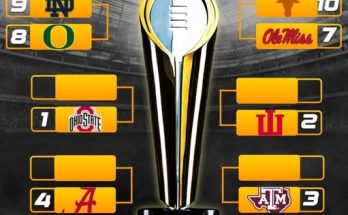In the pantheon of college football legends, few names evoke as much excitement, controversy, and sheer brilliance as Johnny Manziel. The Texas A&M quarterback’s meteoric rise to stardom in 2012 wasn’t just a flash in the pan—it was a seismic shift in how the game was played, perceived, and celebrated. Though his professional career failed to reach the same dizzying heights, Manziel’s collegiate dominance remains the stuff of legend, securing his place among the all-time greats of college football royalty.
From the moment he stepped onto the field as a redshirt freshman, Manziel defied expectations. Nicknamed “Johnny Football,” he wasn’t the prototypical NFL-ready quarterback. He wasn’t built like Cam Newton, nor did he have the polished precision of a Peyton Manning. What he did have, however, was an uncanny ability to turn broken plays into breathtaking highlights, a fearless gunslinger mentality, and an undeniable magnetism that made him must-watch television every Saturday.
The Rise of Johnny Football
Manziel’s legend began in earnest on September 8, 2012, when he led Texas A&M to a near-upset against the Florida Gators in his first career start. Though the Aggies fell short, his 229 passing yards, 89 rushing yards, and two total touchdowns announced his arrival as a force to be reckoned with. But it was his performance against top-ranked Alabama later that season that cemented his legacy.
On November 10, 2012, in Tuscaloosa, Manziel delivered one of the greatest individual performances in college football history. Facing a vaunted Crimson Tide defense loaded with future NFL stars, Manziel threw for 253 yards and two touchdowns while rushing for 92 yards, leading the Aggies to a stunning 29-24 victory. His ability to evade pressure, extend plays, and deliver clutch throws left Nick Saban’s defense—and the entire college football world—in awe. That win not only propelled Manziel into the Heisman conversation but also signaled a changing of the guard in the sport.
The Heisman Moment
By the end of the 2012 season, Manziel had rewritten the record books. He became the first freshman in FBS history to surpass 3,000 passing yards and 1,000 rushing yards in a single season, finishing with 3,706 passing yards, 1,410 rushing yards, and 47 total touchdowns. His improvisational genius and highlight-reel plays made him a household name, and on December 8, 2012, he made history again by becoming the first freshman to win the Heisman Trophy.
His acceptance speech—a mix of humility, charm, and raw emotion—further endeared him to fans. Unlike many polished athletes, Manziel wore his heart on his sleeve, celebrating with the same unbridled passion that he played with. He wasn’t just a star; he was a folk hero, a rebel with a knack for the spectacular.
The 2013 Season and the Weight of Expectations
With fame came scrutiny. Manziel’s off-field antics—partying, autograph controversies, and a brash public persona—often overshadowed his on-field brilliance. Yet, when he stepped between the lines, he remained nearly unstoppable. In 2013, despite facing constant defensive attention and relentless media coverage, Manziel threw for 4,114 yards, rushed for 759 yards, and accounted for 46 touchdowns.
His duel with AJ McCarron and Alabama in 2013 was another classic, as he threw for 464 yards and five touchdowns in a 49-42 loss, further proving that no stage was too big for him. Though the Aggies fell short of championship contention, Manziel’s individual greatness was undeniable.
The Legacy of Johnny Football
Manziel’s NFL flameout—marked by short-lived stints with the Cleveland Browns and various off-field struggles—has led some to dismiss his college achievements. But to do so would be a disservice to his impact on the game. In just two seasons, he revolutionized the quarterback position, proving that a player could dominate with creativity, athleticism, and sheer will as much as with traditional pocket-passing prowess.
His influence is evident in today’s game. Players like Kyler Murray, Lamar Jackson, and even Patrick Mahomes—athletic quarterbacks who thrive outside structure—owe a debt to Manziel’s trailblazing style. College football has always celebrated larger-than-life personalities, but few have matched Manziel’s combination of swagger, production, and cultural relevance.
Where He Stands Among the Greats
When discussing the greatest college football players of all-time, names like Herschel Walker, Barry Sanders, and Tim Tebow inevitably arise. Manziel belongs in that conversation. His statistical dominance, his ability to elevate his team, and his penchant for delivering in the biggest moments place him among the elite.
What separates Manziel from others is the sheer electricity he brought to the sport. He wasn’t just a great player; he was an experience. Whether scrambling for an impossible first down, launching a 50-yard bomb, or celebrating with his trademark “money” gesture, Manziel played with a joy and audacity that captivated millions.



